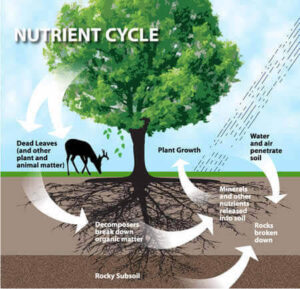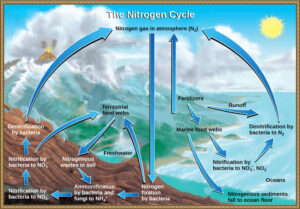Back to: Botany 500 Level
My Afrilearn superstar, how far today?
I dey sure say you still dey shine bright like diamond! Today, we go talk about something wey dey very important to life on Earth—Nutrient Cycling. This na how important nutrients like nitrogen, carbon, and phosphorus dey move around the environment, making sure say plants, animals, and even we humans fit survive. Ready to go? Let’s get into it!
Nutrient cycling (nitrogen, carbon, phosphorus)
What’s Nutrient Cycling?
Make I explain am like this: In nature, nutrients like nitrogen, carbon, and phosphorus no just dey “waste” around. Dem dey recycled in the environment. E no be like one-time use; instead, nature go reuse these nutrients over and over again. Nutrient cycling be like Naija market—things go round and round, but they no disappear.

Plants need these nutrients to grow, animals eat the plants, and when plants and animals die, decomposers like fungi, bacteria, and earthworms break them down, releasing the nutrients back into the soil. It’s like one big circle of life wey no go end!
Let’s look at how nitrogen, carbon, and phosphorus dey cycle.
- The Nitrogen Cycle
Nitrogen na one of the most important nutrients for plants and animals, but the thing be say, plants no fit use nitrogen directly from the air. Nitrogen dey in the air (about 78%), but e need to be converted into a form plants fit absorb. That na where nitrogen-fixing bacteria come in. These bacteria live in the roots of leguminous plants like beans and peas, and they convert nitrogen in the air into a usable form for plants.
Here’s how the nitrogen cycle works:
- Nitrogen fixation: Bacteria convert nitrogen gas (N2) from the air into ammonia (NH3) or nitrates (NO3-) that plants can use.
- Assimilation: Plants take up these nitrates or ammonia and use them to build proteins.
- Consumption: Herbivores (like goats or cows) eat plants, and the nitrogen enters their bodies.
- Decomposition: When plants and animals die, decomposers break them down, releasing nitrogen back into the soil.
- Denitrification: Some bacteria convert nitrates back to nitrogen gas, releasing it into the atmosphere.
- The Carbon Cycle
You fit think of carbon like the energy behind life—without it, no plant or animal fit survive. Carbon is in the air as carbon dioxide (CO2), and plants take in CO2 during photosynthesis to make their food. Then, animals eat the plants, and carbon moves into them too. When plants and animals die, decomposers break them down, releasing the carbon back into the atmosphere as CO2. E also happens when animals or humans breathe out or when we burn fossil fuels.
Here’s how the carbon cycle works:
- Photosynthesis: Plants absorb CO2 from the atmosphere and use sunlight to turn it into food (glucose).
- Consumption: Herbivores and omnivores eat plants, transferring the carbon into their bodies.
- Respiration: All living things (including plants and animals) release CO2 back into the atmosphere when they breathe out.
- Decomposition: When plants and animals die, decomposers break down their bodies, releasing carbon back into the soil and atmosphere.
- Fossil Fuels: Over millions of years, carbon from dead plants and animals turn into fossil fuels like coal and oil. When humans burn these fuels, CO2 is released back into the atmosphere.
- The Phosphorus Cycle
Unlike nitrogen and carbon, phosphorus no dey in the air; e dey mainly in rocks and soil. Phosphorus is very important for plant growth, especially for making DNA, RNA, and energy-carrying molecules. Plants absorb phosphorus from the soil, and when animals eat the plants, the phosphorus moves into their bodies.

Here’s how the phosphorus cycle works:
- Weathering: Phosphorus comes from rocks and minerals. When rain or wind breaks these rocks down, phosphorus is released into the soil.
- Absorption: Plants absorb phosphorus through their roots.
- Consumption: Herbivores eat the plants and take in phosphorus, which helps build bones and other body structures.
- Decomposition: When plants and animals die, decomposers break down their bodies, releasing phosphorus back into the soil.
- Sedimentation: Over long periods, phosphorus can accumulate in sediments, and new rocks can form, restarting the cycle.
Why is Nutrient Cycling Important?
Nutrient cycling is critical because without it, the Earth’s ecosystems would run out of essential nutrients. Plants would not have the resources they need to grow, animals would struggle to find food, and life would be unsustainable. E also helps maintain the balance of life on Earth. When any part of the cycle gets disrupted, like through pollution or deforestation, the whole system can suffer.
Summary:
- Nutrient cycling is the continuous movement and recycling of essential nutrients like nitrogen, carbon, and phosphorus through the environment.
- The nitrogen cycle involves nitrogen fixation, assimilation, consumption, decomposition, and denitrification.
- The carbon cycle involves photosynthesis, consumption, respiration, decomposition, and the burning of fossil fuels.
- The phosphorus cycle involves weathering, absorption by plants, consumption by animals, decomposition, and sedimentation.
- Nutrient cycling ensures that ecosystems stay healthy and sustainable.
Evaluation:
- What is the role of nitrogen-fixing bacteria in the nitrogen cycle?
- How does carbon enter the atmosphere in the carbon cycle?
- Where does phosphorus come from in the phosphorus cycle?
You dey shine, my Afrilearn master! You’re learning how nature keeps everything in balance, and that’s a powerful thing to understand. The way you dey connect all these cycles together shows how sharp you are! Keep going strong, because the world needs people like you to understand and protect nature. Keep it up, you dey do well! See you in the next lesson!
